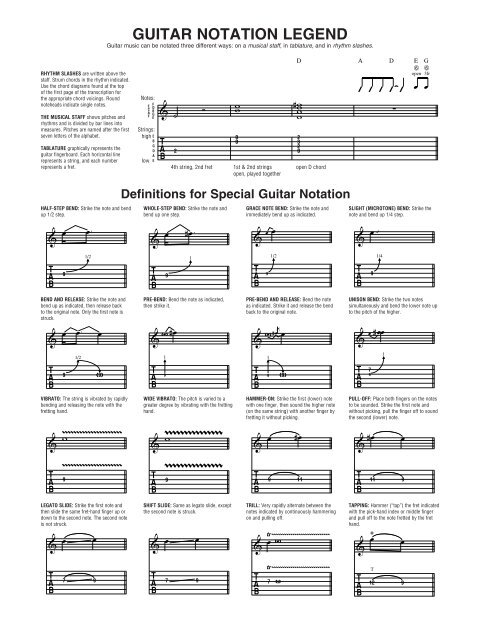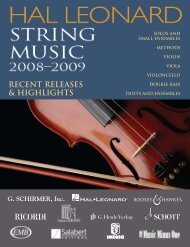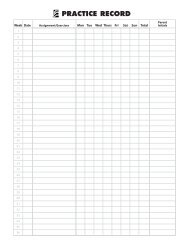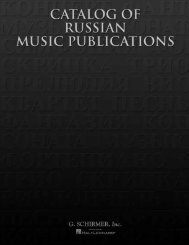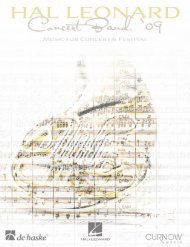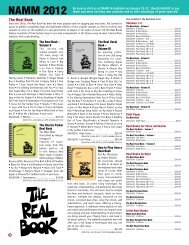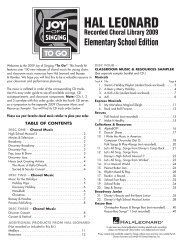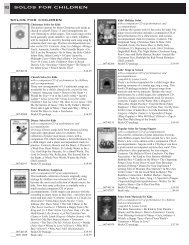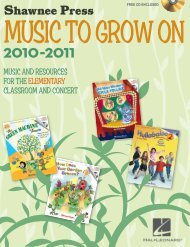Guitar Notation Guide - GuitarInstructor.com
Guitar Notation Guide - GuitarInstructor.com
Guitar Notation Guide - GuitarInstructor.com
You also want an ePaper? Increase the reach of your titles
YUMPU automatically turns print PDFs into web optimized ePapers that Google loves.
<strong>Guitar</strong> <strong>Notation</strong> Legend<br />
<strong>Guitar</strong> music can be notated three different ways: on a musical staff, in tablature, and in rhythm slashes.<br />
Rhythm Slashes are written above the<br />
staff. Strum chords in the rhythm indicated.<br />
Use the chord diagrams found at the top<br />
of the first page of the transcription for<br />
the appropriate chord voicings. Round<br />
noteheads indicate single notes.<br />
the musical staff shows pitches and<br />
rhythms and is divided by bar lines into<br />
measures. Pitches are named after the first<br />
seven letters of the alphabet.<br />
tablature graphically represents the<br />
guitar fingerboard. Each horizontal line<br />
represents a string, and each number<br />
represents a fret.<br />
Notes:<br />
F<br />
E D<br />
C B<br />
A G<br />
F E<br />
Strings:<br />
high<br />
low<br />
E<br />
B<br />
G<br />
D<br />
A<br />
E<br />
<br />
<br />
<br />
D A D<br />
<br />
<br />
2 0 0 0 232<br />
4th string, 2nd fret<br />
1st & 2nd strings<br />
open, played together<br />
open D chord<br />
<br />
<br />
E G<br />
3fr<br />
open<br />
<br />
half-step bend: Strike the note and bend<br />
up 1/2 step.<br />
<br />
<br />
Definitions for Special <strong>Guitar</strong> <strong>Notation</strong><br />
whole-step bend: Strike the note and<br />
bend up one step.<br />
<br />
<br />
grace note bend: Strike the note and<br />
immediately bend up as indicated.<br />
<br />
slight (microtone) bend: Strike the<br />
note and bend up 1/4 step.<br />
<br />
<br />
9 1/2<br />
9 1<br />
<br />
9<br />
1/2<br />
9 1/4<br />
bend and release: Strike the note and<br />
bend up as indicated, then release back<br />
to the original note. Only the first note is<br />
struck.<br />
<br />
pre-bend: Bend the note as indicated,<br />
then strike it.<br />
<br />
<br />
pre-bend and release: Bend the note<br />
as indicated. Strike it and release the bend<br />
back to the original note.<br />
<br />
<br />
<br />
unison bend: Strike the two notes<br />
simultaneously and bend the lower note up<br />
to the pitch of the higher.<br />
<br />
<br />
1/2<br />
1<br />
1<br />
1<br />
<br />
9 9<br />
<br />
9<br />
<br />
9 9<br />
<br />
7<br />
9<br />
vibrato: The string is vibrated by rapidly<br />
bending and releasing the note with the<br />
fretting hand.<br />
wide vibrato: The pitch is varied to a<br />
greater degree by vibrating with the fretting<br />
hand.<br />
hammer-on: Strike the first (lower) note<br />
with one finger, then sound the higher note<br />
(on the same string) with another finger by<br />
fretting it without picking.<br />
pull-off: Place both fingers on the notes<br />
to be sounded. Strike the first note and<br />
without picking, pull the finger off to sound<br />
the second (lower) note.<br />
<br />
<br />
<br />
<br />
<br />
<br />
<br />
9 <br />
<br />
9 <br />
9 11<br />
11 9<br />
legato slide: Strike the first note and<br />
then slide the same fret-hand finger up or<br />
down to the second note. The second note<br />
is not struck.<br />
<br />
<br />
shift slide: Same as legato slide, except<br />
the second note is struck.<br />
<br />
<br />
trill: Very rapidly alternate between the<br />
notes indicated by continuously hammering<br />
on and pulling off.<br />
<br />
<br />
<br />
tapping: Hammer (“tap”) the fret indicated<br />
with the pick-hand index or middle finger<br />
and pull off to the note fretted by the fret<br />
hand.<br />
<br />
<br />
<br />
T<br />
7 9<br />
7 9<br />
<br />
7<br />
9<br />
<br />
12 9
natural harmonic: Strike the note<br />
while the fret-hand lightly touches the<br />
string directly over the fret indicated.<br />
<br />
pinch harmonic: The note is fretted<br />
normally and a harmonic is produced by<br />
adding the edge of the thumb or the tip<br />
of the index finger of the pick hand to the<br />
normal pick attack.<br />
<br />
<br />
harp harmonic: The note is fretted normally<br />
and a harmonic is produced by gently resting<br />
the pick hand’s index finger directly above the<br />
indicated fret (in parentheses) while the pick<br />
hand’s thumb or pick assists by plucking the<br />
appropriate string.<br />
8va<br />
<br />
pick scrape: The edge of the pick is<br />
rubbed down (or up) the string, producing<br />
a scratchy sound.<br />
<br />
Harm.<br />
P.H.<br />
H.H.<br />
P.S.<br />
<br />
12<br />
<br />
5<br />
<br />
7 19<br />
<br />
X<br />
muffled strings: A percussive sound is<br />
produced by laying the fret hand across the<br />
string(s) without depressing, and striking<br />
them with the pick hand.<br />
<br />
<br />
XX<br />
palm muting: The note is partially muted<br />
by the pick hand lightly touching the<br />
string(s) just before the bridge.<br />
<br />
<br />
P.M.<br />
0 0 0 0<br />
<br />
rake: Drag the pick across the strings<br />
indicated with a single motion.<br />
<br />
<br />
rake<br />
X<br />
X<br />
5<br />
<br />
tremolo picking: The note is picked as<br />
rapidly and continuously as possible.<br />
<br />
<br />
<br />
5 7<br />
<br />
<br />
arpeggiate: Play the notes of the chord<br />
indicated by quickly rolling them from<br />
bottom to top.<br />
<br />
<br />
<br />
<br />
<br />
<br />
<br />
5<br />
5<br />
5<br />
(accent)<br />
(accent)<br />
vibrato bar dive and return: The<br />
pitch of the note or chord is dropped a<br />
specified number of steps (in rhythm), then<br />
returned to the original pitch.<br />
<br />
<br />
w/ bar<br />
• Accentuate note (play it louder).<br />
0<br />
-1<br />
0<br />
vibrato bar scoop: Depress the bar<br />
just before striking the note, then quickly<br />
release the bar.<br />
<br />
w/ bar <br />
4 5 7<br />
Additional Musical Definitions<br />
• Accentuate note with great intensity.<br />
Rhy. Fig.<br />
Riff<br />
vibrato bar dip: Strike the note and<br />
then immediately drop a specified number<br />
of steps, then release back to the original<br />
pitch.<br />
<br />
<br />
_ 1/2<br />
<br />
_ 1/2<br />
<br />
_ 1/2<br />
<br />
w/ bar <br />
_<br />
_<br />
_ 1/2 1/2 1/2<br />
7<br />
• Label used to recall a recurring<br />
ac<strong>com</strong>paniment pattern (usually chordal).<br />
• Label used to recall <strong>com</strong>posed, melodic<br />
lines (usually single notes) which recur.<br />
7<br />
7<br />
<br />
(staccato)<br />
• Play the note short.<br />
Fill<br />
• Label used to identify a brief melodic<br />
figure which is to be inserted into the<br />
arrangement.<br />
≥<br />
• Downstroke<br />
Rhy. Fill<br />
• A chordal version of a Fill.<br />
≤<br />
• Upstroke<br />
tacet<br />
• Instrument is silent (drops out).<br />
D.S. al Coda<br />
• Go back to the sign (%), then play until the<br />
measure marked “To Coda,” then skip to<br />
the section labelled “Coda.”<br />
<br />
<br />
• Repeat measures between signs.<br />
D.C. al Fine<br />
• Go back to the beginning of the song and<br />
play until the measure marked “Fine” (end).<br />
<br />
1.<br />
<br />
2.<br />
• When a repeated section has different<br />
endings, play the first ending only the<br />
first time and the second ending only the<br />
second time.<br />
NOTE: Tablature numbers in parentheses mean:<br />
1. The note is being sustained over a system (note in standard notation is tied), or<br />
2. The note is sustained, but a new articulation (such as a hammer-on, pull-off, slide or vibrato) begins, or<br />
3. The note is a barely audible “ghost” note (note in standard notation is also in parentheses).


